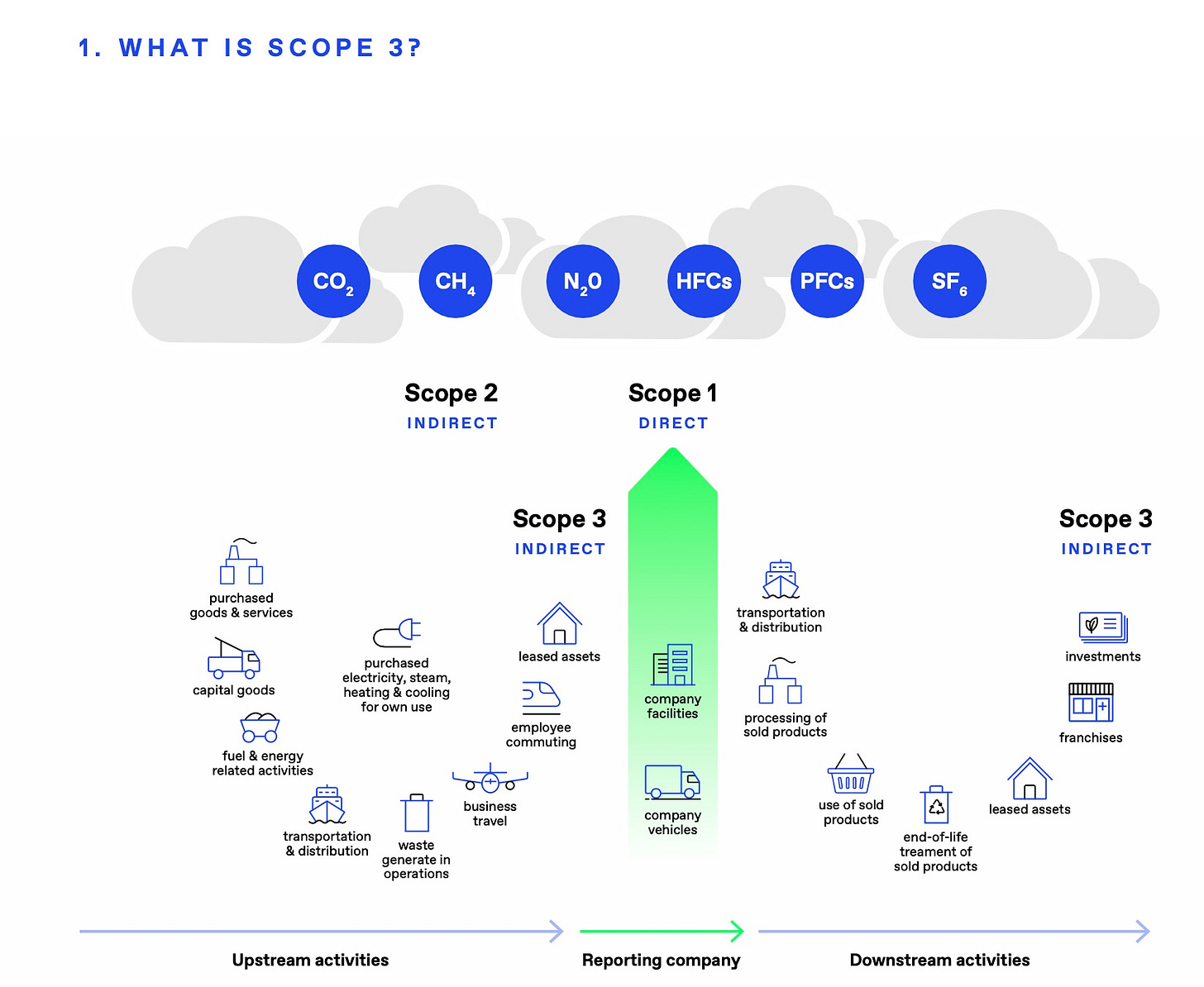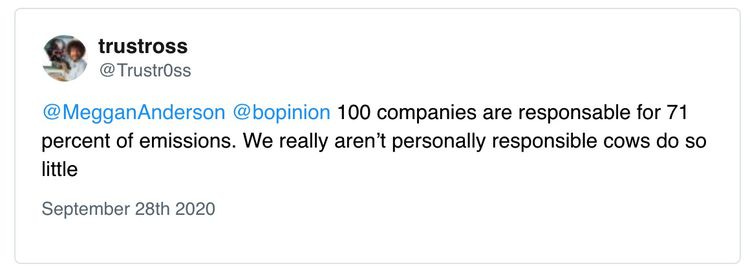Scoping out carbon emissions
There are currently three scopes of carbon emissions; now a fourth is being proposed, and I think this is a problem.
Just last week, I wrote a post, How much does a tonne of carbon dioxide weigh? that was a riff on a post by Alex Bantock of Preoptima; now I am about to do it again. This shouldn’t be surprising; they are in the business of measuring embodied carbon emissions, and I am in the business of writing a book (The Story of Upfront Carbon, coming from New Society Publishers, next year!) about them. In her current post, Alex asks, “What are Scope 4 Avoided Emissions?” and describes them as “the emission reductions that occur outside of a product's life cycle or value chain but as a result of the product.” In the building industry, avoided emissions might come from switching from concrete to mass timber.
First, let’s explain what the first 3 scopes are. Alex starts by noting the 2017 Carbon Majors Report, which was covered in the Guardian with the title “Just 100 companies responsible for 71% of global emissions.” The Guardian never mentions scopes, but the report does:
Scope 1 emissions arise from the self-consumption of fuel, flaring, and venting or fugitive releases of methane.
Scope 3 emissions account for 90% of total company emissions and result from the downstream combustion of coal, oil, and gas for energy purposes. A small fraction of fossil fuel production is used in non-energy applications which sequester carbon. [like plastics]
So Scope 1 emissions come directly from making stuff, Scope 2 emissions are indirect emissions, such as buying electricity to run the equipment to make the Scope 1 stuff, and don’t amount to much in the oil industry, but 90% of emissions from these companies are Scope 3, which is us, buying what they are selling, putting it in our gas tanks and burning it in our cars. They are the downstream emissions that are so important; according to the Carbon Trust, “these emissions are typically responsible for 70-90% of an organization’s carbon footprint.” Alex suggests that the Carbon Majors report shocked the world, but it also confused the world about the nature of Scope 3 emissions which are often misunderstood or ignored or misused; I have been collecting tweets:
So these people all buy Bitcoin, run air conditioners, eat hamburgers, and even fly private jets, avoiding any personal responsibility and blaming the oil companies for their own consumption and emissions.
That’s misunderstanding Scope 3. (more in Stop It With the '100 Companies Responsible for 71% of Carbon Emissions' Already)
Now Preoptima wants to introduce what they call Scope 4 emissions, or avoided emissions.
“The integration of Scope 4 emissions into carbon accounting is important to provide companies with a more holistic view of a company's short- and long-term impacts. It provides a forward-thinking and proactive approach to carbon management, unlike the 'reactive' approach of Scopes 1 to 3 (where the aim is to reduce existing emissions), Scope 4 encourages 'proactive' steps to help prevent emissions from occurring in the first place… We now have to prioritise ‘avoidance’ over 'reduction' and ensure that we prevent emissions from being released from the outset. This additional layer of carbon reporting will encourage organisations to both use carbon-saving products and methodologies, as well innovate them.”
Yes, but this is like me going on a diet to lose weight and eating a tofu dinner instead of a hamburger, and then crediting myself with the calories saved by not eating a hamburger. Who does that?
In my Treehugger days, I reviewed a big mass timber project by a prominent “sustainable” architect who counted all the stored carbon in the massive, oversized columns and beams (it was designed with a big grid for flexibility rather than being optimized for fibre) and counted all the avoided carbon from not building out of concrete, added them together and called his building “carbon positive” even though it had a massive concrete parking garage and podium. This is fuzzy, wrongheaded math.
I asked Francesco Pomponi, founder of Preoptima, about this, and he responded on LinkedIn:
“Hi Lloyd, of course, that’s a risk with the interpretative room that goes with it. What we were trying to show is moving from reactive approaches ( I have a product with an impact, now let me make it 5% better and say I’m doing things to save the planet) to a proactive one (what if I switch to material A to material B completely). I don’t think the two should, however, be compared to give credits or any claim of carbon neutrality, it’s more about mindset shifting.”
There is certainly value in knowing how much is being saved by switching to lower-carbon materials, just as there is value in knowing how many calories are in my hamburger. I can see how it can shift mindsets. But should it be Scope-ified? Alex Bantock notes in her post about the double-edged sword,":
“Avoided emissions should not be seen as an ‘easy out’ for Scope 1, 2 and 3 emissions (or as a means to ’offset’ these emissions), as they are completely unrelated to the GHG Protocol and avoided emissions are not captured within these scopes. In addition, there is no generally accepted methodology for calculating and reporting on Scope 4 emissions, presenting risks of significant variation in the calculation and communication of Scope 4 emissions and the potential of greenwashing.”
But I can’t help thinking that calling avoided emissions “Scope 4” legitimizes them, and believe that misunderstanding and misusing them will be worse than what we have with Scope 3. I go back to my food analogy: Hamburgers have a big carbon footprint and should be avoided where possible, but I am not counting each one I skip. Similarly, proudly counting avoided carbon when sitting on a giant parking garage and calling it “carbon positive” is greenwashing. It is hard enough to get people to understand what Scope 3 is; do we want to go down this road with Scope 4?
Once again, apologies to Preoptima for focusing on them two weeks in a row. They are doing great stuff, but I have upfront carbon on the brain these days.
UPDATE: Alexandra Bantock points out that people have been talking about accounting for avoided emissions for a while, including The World Resources Institute back in 2013.









Thought-provoking stuff Lloyd, thank you. I saw a company today claiming they had reduced their emissions by 15% but that was a combination of scope 1, scope 2 and scope 3 - combining the three of the, to my mind, makes the number absolutely meaningless because I don't know if they actually did anything (it is a paper manufacturer and recycler) or if it was their customers who used recycling bins more and therefore drove the scope 3 emissions down? Meanwhile their scope 1 and 2 emissions might have gone up!
If we baseline everything as being expected to be 0 or net0 emmisions it is so much more straightforward.
In this framework scope 3 is double counting. Even scope 2, if the emmisions are scope 1 for the generator.
This framework pairs well with a significant carbon price. Then price also reflects embodied emmisions,.which makes choosing lower scope 3 products easier, without needing direct accounting. But the producer would have primary responsibility still.